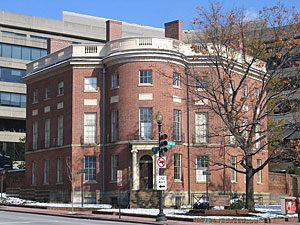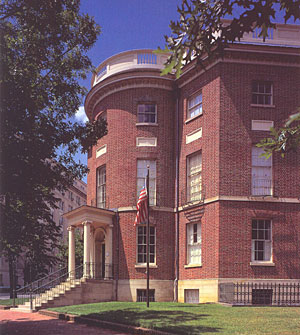The American Institute of Architects is regaining stewardship of a national architectural treasure: the 210-year-old Octagon building in Washington, D.C.


The American Architectural Foundation is transferring ownership of the Octagon building to AIA Legacy, the nonprofit arm of the American Institute of Architects.
In an agreement announced today, the building’s current owner, the American Architectural Foundation (AAF), will transfer the deed to AIA Legacy, the nonprofit arm of the institute. The AAF, founded in 1943 to educate the public about architecture, will remain in the three-story brick building for the foreseeable future. Approximately 11 of its 15 staff members work there.
As part of the agreement, the AIA will continue to offer the AAF financial support through 2015. Those involved emphasize, however, that the transfer of Octagon ownership was not prompted by current financial woes; rather, it stems from a discussion that began at least two years ago regarding how the AIA and AAF can best collaborate. “It’s not related to contemporary economic issues,” explains Ronald Bogle, AAF president and CEO.
The Federal-style Octagon, designed by architect William Thornton and completed in 1799, is located on the same site as the AIA’s Modernist headquarters on New York Avenue, near the White House. The Octagon—which actually has six sides, not eight, and was designed to accommodate an irregularly shaped lot—was one of the first residences built in Washington, D.C., and was the first American house museum to be accredited by the American Association of Museums, according to the AAF. In 1970, it was deemed a National Historic Landmark.
The AIA, founded in 1857, purchased the building in 1900 for use as its headquarters. In 1968, it deeded the Octagon to the AAF. After undergoing a major renovation in the early 1990s, the building is in the midst of a second renovation funded by the National Park Service and the AIA 150 campaign. (A renovation of the AIA headquarters, designed by The Architects Collaborative and built in 1973, also is under way, although has been temporarily put on hold due to the troubled economy, according to an AIA spokesman.)
The transfer of Octagon stewardship was not the only news announced today by the AIA and AFF. The AIA also is taking full control of the AIA/AFF Minority-Disadvantaged Scholarship Program, which offers financial support to high school seniors and college freshmen who plan to study architecture. The program, which bestows 20 awards per year ranging from $500 to $2,500, was established in 1970 via a Ford Foundation grant. With the procurement of this program, the national AIA now has at least six student financial aid programs.
In addition, the foundation will no longer handle the logistics associated with conferring the AIA’s Gold Medal, Firm Award, and Twenty-Five Year Award at the annual Accent on Architecture Gala; instead, the AIA will present those awards, either at the gala or a different event. Details are yet to be decided.
The acquisition of the Octagon and the scholarship program will boost the AIA’s ability to engage the public and to promote diversity in the profession, explains AIA President Marvin J. Malecha, FAIA. “The future of the AIA encompasses both the rich history of architecture embodied in the Octagon,” he says, “and the financial support for new generations to become tomorrow’s architects.”



Post a comment to this article
Report Abusive Comment